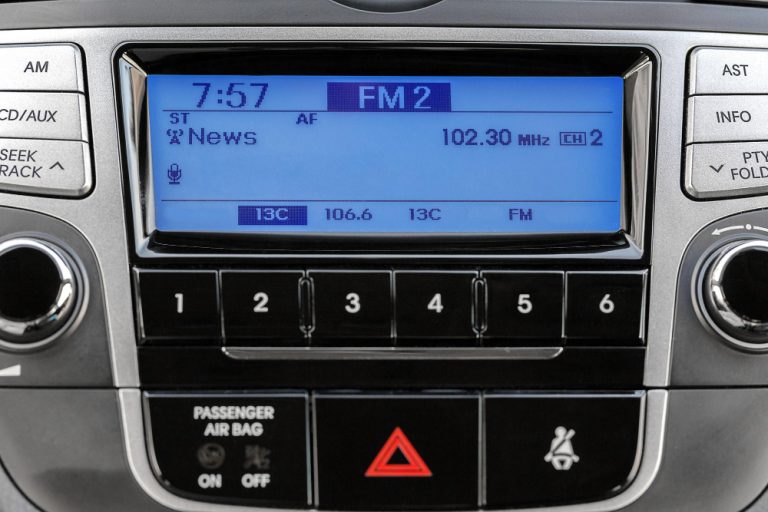Radio
Eine oftmals unterschätzte Komponente der HiFi-Anlage. Leider ist in vielen Fahrzeugen der Tausch des Radios nicht mehr möglich, da auf dem Radiodisplay auch die Einstellung von z.B. der Klimaanlage angezeigt werden. In diesem fall kann man nur den Funktionsumfang der Radios durch externe Module erweitern und muss sich mit der HiFi-Qualität des Originalradios zufriedengeben. Häufig werden aber auch von der Industrie passende Adapterblenden angeboten, die es ermöglichen, die Radios, die optisch an das Armaturenbrett angepasst sind, durch universelle Radios in der 1-DIN- oder 2-DIN-Größe zu tauschen.
Der Hersteller Zenec hat sich darauf spezialisiert, Headunits zu bauen, die optisch den Originalgeräten entsprechen und die Fahrzeugelektronik voll unterstützen. Radios von Zenec gibt es für viele gängige Fahrzeuge, leider aber nicht für alle.
Lautsprecher
Eine wichtige, aber nicht die einzige Komponenten, die über die Soundqualität entscheidet. Viele Kunden verdächtigen den Lautsprecher, wenn dieser in einer Originalanlage verzerrt, obwohl meist eher fehlende Verstärkerleistung und das Fehlen eines externen Subwoofers Schuld am miesen Klang ist. Trotzdem gibt es natürlich riesige Klangunterschiede zwischen den billigen Originalchassis und hochwertigen Nachrüstlautsprechern.
Die besten Erfahrungen haben wir mit dem deutschen Lautsprecherhersteller Eton und den Lautsprechern von Focal gemacht, die größtenteils in Frankreich produziert werden. Profitieren Sie von unserer Erfahrung, welcher Lautsprecher in Ihrem Fahrzeug das beste Ergebnis liefert!
Verstärker
Da in den genormten Einbauschächten der Autoradios nicht viel Platz für Verstärkerelektronik ist und die Belüftungssituation auch alles andere als Perfekt ist, beschränkt sich die Ausgangsleistung bei Autoradios meist auf ca. 20 Watt RMS pro Kanal. Wenn man hiermit auch nur etwas lauter als Zimmerlautstärke hören will, fängt der Lautsprecher schnell an zu verzerren. Schnell wird der „minderwertige Lautsprecher“ verdächtigt, aber der Fehler liegt ganz woanders. Die Lautsprecher können noch viel lauter, verzerrungsfrei spielen, wenn Sie nur genug Leistung bekämen. Hier setzten wir mit externen Verstärkern an, die entweder analog oder digital aufgebaut sind. Die digitalen haben den Vorteil, dass sie deutlich kleiner (durch kleinere Kühlkörper/ weniger Hitzeentwicklung) sind und mit dünneren Stromkabeln betrieben werden können. Dem gegenüber stehen die analogen Endstufen mit ihrem warmen Klang und der lautsprecherschonenden Bauweise. Beide Varianten gibt es als 1-, 2-, 4- oder 5-Kanal-Version, so dass wir einen riesige Auswahl haben, um Ihr Auto mit der passenden Endstufe aufzuwerten.
Interessant sind auch die vielen Plug-and-Play-Endstufen. Sie werden einfach zwischen den Fahrzeugkabelbaum und das Autoradio gesteckt und minimieren so den Einbauaufwand deutlich.
Subwoofer
Subwoofer haben noch immer das schlechte Image der riesigen Basskisten, die in den 90er-Jahren die Kofferräume der Fahrzeuge komplett ausfüllten und deren Besitzer von weiten hörbar machten. Auf der anderen Seite hat Audi den Zauber dieser Wunderkisten schon vor 15 Jahren erkannt und in fast alle Ihrer Modell dezent hinter den Verkleidungen platziert und den meisten Audifahrern ein Lächeln auf die Lippen gezaubert. Inzwischen muss man einfach feststellen, dass zu einem ausgewogenene voluminösen klang auch ein gewisser Bassanteil gehört, den Hoch-Mitteltonsystem einfach nicht wiedergeben können. Glücklicherweise hat die Industrie aber in letzter Zeit sehr viel Entwicklungsarbeit in die Konstruktion dieser Gehäuse gesteckt und damit Basslösungen geschaffen, die entweder in die Reserveradmulde oder unter den Sitz passen, oder so kompakt sind, dass sie nur geringfügig Platz im Kofferraum wegnehmen.
Des weiteren gibt es auf dem Markt inzwischen eine Vielzahl von Aktivsubwoofern. Diese Basskisten beinhalten gleichzeitig einen Verstärker und werten Originalsoundsysteme deutlich auf, ohne viel Geld zu kosten. Insbesondere Axton hat hier mit dem Modell AB20A und dem Nachfolger AXB20A zwei Modelle geschaffen, die sich größter Beliebtheit erfreuen.
DSP
Eine gute Musikqualität im Wohnzimmer zu reproduzieren ist relativ einfach. Im Fahrzeug hat der Einbauer hingegen mit einer Vielzahl von Problemen zu kämpfen: Man sitzt nicht mittig zwischen den Lautsprechern, der Ton wird von einer Vielzahl unterschiedlicher Materialien reflektiert und die Einbauplätze sind meist alles andere also optimal angeordnet. Dies ist nur ein Auszug der Schwierigkeiten auf die es zu reagieren gilt. Ein wunderbares Werkszeug hierfür heißt DSP, was die Abkürzung von „Digitaler Sound Prozessor“ ist. Dieses elektronische Bauteil wird zwischen Radio und Verstärker verbaut, oder ist manchmal auch im Radio oder im Verstärker integriert und bietet interessante Möglichkeiten:
– Durch eine integrierte Frequenzweiche kann man jedem einzelnen Lautsprecher genau den Frequenzbereich zuordnen, für den er gebaut wurde.
– Zahlreiche Frequenzbänder ermöglichen es, den einzelnen Lautsprechern bei einzelnen, fein abgestuften Frequenzbereichen Leistung zuzugeben oder wegzunehmen, und damit den Lautsprecher hier lauter oder leiser spielen zu lassen.
– Durch eine Laufzeitkorrektur kann man jeden einzelnen Lautsprecher in seiner Abspielzeit verzögern. Dadurch sitzt man unter Berücksichtigung der Schallgeschwindigkeit wieder gleich weit von allen Lautsprechern entfernt. Der Eindruck, “alles kommt von vorne links“ verschwindet und man kann die Lautsprechersysteme (Hoch- Mittel- und Tieftöner) wieder zu einer einzigen Klangquelle vereinen.
Wir können mithilfe unserer computergestützten Messsysteme und unserem geschulten Ohr die HiFi-Anlagen perfekt einstellen und ihnen so zu einem neuen unvergesslichen Klangerlebnis verhelfen!
Dämmung
Jeder Lautsprecher regt die ihn umgebenden Kunststoff- und Metallteile zum Mitschwingen an. Da die Fahrzeugbleche heutzutage aus Gewichtsgründen immer dünner werden, führt dies oftmals zu unangenehmen Klappern und metallischen Resonanzen. Diesem Effekt kann man mit einer Dämmung entgegenwirken. Dazu werden auf die Bleche oder Kunststoffteile Matten aus Alubutyl oder Schaumstoff geklebt, die verhindern, dass dir Schwingungen weitergegeben werden.
Klappergeräusche werden vermieden, die Audiowiedergabe der Lautsprecher wird präziser und der Fahrkomfort wird verbessert.


